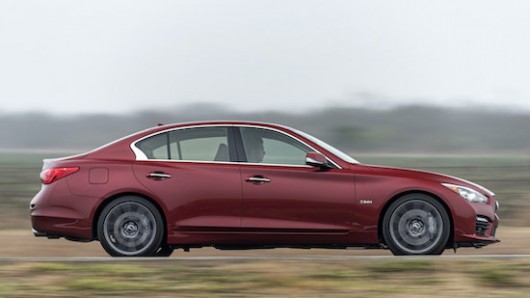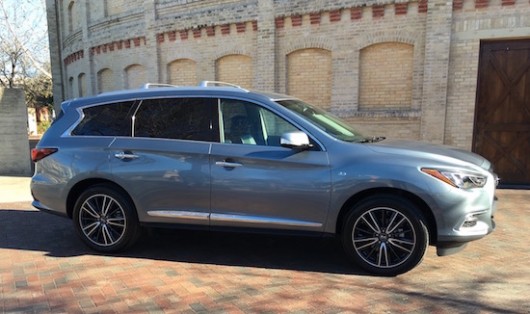Infiniti Upgrades Mid-Size Vehicles Mid-Cycle
- February 29, 2016
- Infiniti, Manufacturers, Mercedes-Benz, New Model Introductions, More Categories...
- Posted by George Peterson
- Comments Off on Infiniti Upgrades Mid-Size Vehicles Mid-Cycle
Nissan’s luxury brand, Infiniti, is upgrading its two mid-size entries in the middle of their product cycle. This is not unusual these days as carmakers attempt to keep up with new technologies and keep fresh products available to their buyers. Infiniti’s one-two punch comes with new powertrains for the Q50 (nee G35/37) rear wheel drive mid-size sedan and freshened styling for the QX60 (nee JX35) front wheel drive/AWD mid-size crossover SUV.
The Q50 changes target enthusiasts and the QX60 changes target families. Let’s talk about the Q50 first.
Q50 Powertrain Updates Infiniti positions the Q50 against the Lexus IS and the BMW 3-Series. To us, it is closer to the Lexus GS350 in size and ambiance, but priced lower. Q50 looks the same as before. Its changes come in the form of new engines. The top-of-the-line is the Infiniti Q50 Red Sport 400. What does all that mean? The “400” is for the 400-horsepower twin turbo 3.0L V6 engine. “Red Sport” refers to the red “S” sport badge on the fenders and rear of the vehicle. The Red Sport 400 is very flexible from easily lumping around town in stop and go traffic, to quickly running rural roads. With several drive selections from Eco to Sport+ available, the personality of the car can transform dramatically. In Sport + mode throwing the car around sharp curves over undulating terrain is a blast. A fully loaded Q50 Red Sport 400 should set you back around $55,000 although pricing has not been finalized. About 20%-25% of Q50 mix will be Red Sport 400 models.
Rounding out the new powertrain news for the Q50 is the high volume engine which is a de-tuned version of the Red Sport 400 – a twin turbo V6 with 300-horsepower. This will be on 50%-60% of the volume. The Infiniti Q50 2.0t is powered by an all-new base engine developed with Daimler – a turbo 2.0L 4-cylinder with 208-horsepower. This will be on about 20%-25% of the Q50s sold. The power output of the 4-cylinder seems pretty anemic. Other 2.0L turbo 4s on offer today are more common with between 230 and 240-horsepower. Some even have as much as 270-horsepower. Infiniti says only the basic engine design is from Daimler. All the accessories and systems engineering were by Nissan engineers. The engine is produced in Infiniti’s Decherd, Tennessee Engine Plant.
QX60 Freshening Moderately Extensive The QX60 is Infiniti’s mid-market family hauler. It is in the middle of an SUV lineup that includes the flagship QX80 (formerly QX56), the “urban gorilla” QX70 (nee FX35/45/50). Below the QX60 is the QX50 (nee EX35) and the upcoming QX30 (based on a Mercedes 5-door bodystyle).
The 2016 QX60 looks pretty much the same as the 2016 model, but it does have new front and rear styling that evolves slightly from the 2015 version. The grille and headlamps are new and now de rigeur LED accent running lights are part of the headlamp design. Outside mirror-mounted turn signals are standard. The taillamps and liftgate are new, but look similar to their predecessor. Inside, the seat trim is new with more intricate sew styles. The instrument panel upper is softer and looks more appropriate for luxury brand vehicle. Driver assist technologies abound.
Responding to criticisms about ride control and handling, Nissan upgraded the suspension. While ride comfort was excellent, body lean in cornering was excessive. The update to the suspension yields a vehicle that is more confident feeling, more nimble and lighter on its feet. This is a very positive move forward.
While these updates to Infiniti’s mid-market entries are not earth shaking, they keep the vehicles fresh and up-to-date. The changes to the QX60 are more extensive, but the powertrain changes to the Q50 will get the most attention. Both are good moves.



